Australia’s housing crisis is deepening - Nothing new from Doriana Pojani in the face of a manufactured crisis
 Dr Dorina Pojani is Associate in urban planning at the University of Queensland, Australia, with a degree in Urban Planning from Albania.
Dr Dorina Pojani is Associate in urban planning at the University of Queensland, Australia, with a degree in Urban Planning from Albania.
 Dr Dorina Pojani is Associate in urban planning at the University of Queensland, Australia, with a degree in Urban Planning from Albania.
Dr Dorina Pojani is Associate in urban planning at the University of Queensland, Australia, with a degree in Urban Planning from Albania.
More and more farming land is being lost to other land uses such as housing on the outskirts of our cities. But how much land is being lost? And why does it matter?
 " ... We end [up] waging war against Russians with the proxy. We are investing our emotions just like playing a computer game. Unable to distinguish dying in a computer game from dying for real. When we die, we might start another game. Ukrainians, after being dead once, can not do that. No more games after dying for real.
" ... We end [up] waging war against Russians with the proxy. We are investing our emotions just like playing a computer game. Unable to distinguish dying in a computer game from dying for real. When we die, we might start another game. Ukrainians, after being dead once, can not do that. No more games after dying for real.
The world does not need Putin’s propaganda to recognise the bullshit of actual American Realpolitik and worldwide consequences. Neither the world needs bullshit of Western propaganda behind articles like this one to imply the cowboy politics of ‘bad guys versus good guys’ and some ‘fantastic’ moral values behind Western neoliberal political strategies.
 Dear Censorial Overseers
Dear Censorial Overseers
The deletion of the comment quoted below in this notification is perhaps the most odious of all those made under this article today, all done without any clearly discernible reason but with quite evident rhyme. The comment below asks you to show respect for these commentators who have suffered deletion of their genuine and reasonable comment by providing an open advice as to the basis of that consistent disbursement of negative action.
The unavoidable message from your early closure of comments, following directly upon the posting of the request for your reasoned advice, is that you do not have respect for your reader and commenters. It also clearly demonstrates your publication’s covert imposition of a controlled narrative rather than being the relatively free arena for informed adult conversation that your promotion pretends you to be.
As I’ve already made mention of, as the repetitive and unexplained evidence mounted, your pretence and hypocrisy as an intellectual forum is comical; sadly, bleakly, disturbingly so, but comical nonetheless.
With some good fortune the cumulative load of Covid19 distress will be the death of your horridly sneaky and cynical enterprise. Hopefully, well-meaning staff will then find some useful jobs in which to sustain themselves within a wider community in need of real re-construction that is free of the property development, migration agency and associated Empire roles that your sponsors pursue ahead of real education, with the active assistance of this mouthpiece.
Kindest regards
Greg Wood

On 14 Apr 2020, at 4:51 pm, The Conversation
Hello Greg,
Your comment on ‘Why is it so hard to stop COVID-19 misinformation spreading on social media?’ has been removed.
There are several reasons why this may have occurred:
Your comment may have breached our community standards. For example it may have been a personal attack, or you might not have used your real name.
Your comment may have been entirely blameless but part of a thread that was removed because another comment had to be removed.
It might have been removed for another editorial reason, for example to avoid repetition or keep the conversation on topic.
For practical reasons we reserve the right to remove any comment and all decisions must be final, but please don’t take it personally.
If you’re playing by the rules it’s unlikely to happen again, so feel free to continue to post new comments and engage in polite and respectful discussion.
For your reference, the removed comment was:
Moderators have removed an entirely rational and reasonable comment by Duncan Mouat. The pattern of deletions is now profuse and appears to be quite consistent in its objection and purpose. Given the repetition and evidently convergent aim of these deletions, can the moderators please provide a clear statement regarding the exact standard(s) these posts are deemed to have offended.
I propose that due respect for your readers and contributors requires nothing less. We should not be left guessing what the editors’ position is on these matters wherein no insult or off-topic commentary has occurred.
Please understand that these deletions resonate especially loudly within a discussion that essentially reflects upon intent censorship.
For more information you can read our standards.
Kind regards,
The Conversation
 This very informative article is republished from The Conversation. It is written by Holly Cullen, Adjunct professor, University of Western Australia. It is unusually clear in its explanation of various legal and political possibilities in Julian Assange's predicament. We were not aware of some of the ideas expressed in the article, although we have been following this case pretty closely at Candobetter.
This very informative article is republished from The Conversation. It is written by Holly Cullen, Adjunct professor, University of Western Australia. It is unusually clear in its explanation of various legal and political possibilities in Julian Assange's predicament. We were not aware of some of the ideas expressed in the article, although we have been following this case pretty closely at Candobetter.
Julian Assange, the Australian cofounder of Wikileaks, was arrested on April 11 by British police at the Ecuadorian embassy in London, where he had been claiming political asylum for almost seven years.
He has faced a range of criminal charges and extradition orders, and several crucial aspects of his situation remain to be resolved.
What are the British charges against Assange, and what sentence could be imposed?
Assange moved into the Ecuadorian embassy in London in June 2012 after losing the final appeal against his transfer to Sweden on a European Arrest Warrant (EAW). He was then charged with failing to surrender to the court.
While in the embassy, Assange could not be arrested because of the international legal protection of diplomatic premises, which meant police could not enter without Ecuador’s consent. On April 11, British police were invited into the embassy and made the arrest. On the same day, Assange was found guilty, and awaits sentencing. The charge of failing to surrender to the court carries a jail term of up to 12 months.
What are the US charges against Assange?
Also on April 11, the United States government unsealed an indictment made in March 2018, charging Assange with a conspiracy to help whistleblower Chelsea Manning crack a password which enabled her to pass on classified documents that were then published by WikiLeaks. The US has requested that the UK extradite Assange to face these charges before a US court.
What were the Swedish charges, and could they be revived?
In 2010, a Swedish prosecutor issued the EAW requesting Assange’s transfer to Sweden to face sexual assault allegations, which he denies. In 2016, Assange was questioned by Swedish authorities by video link while he remained in the Ecuadorian embassy. In 2017, they closed their investigation.
After Assange was arrested and removed from the embassy, the lawyer for one of the complainants indicated she would ask the prosecutor to reopen the case, as the statute of limitations on the alleged offence does not expire until 2020. As of April 12, Sweden’s Prosecution Authority is formally reviewing the case and could renew its request for extradition.
What are Britain’s legal obligations to extradite to Sweden or the US?
The UK, as a member of the European Union (for now!), is obliged to execute an EAW. The law on EAWs is similar to extradition treaties. However, the law also says it is up to the UK to decide whether to act first on the EAW from Sweden or the US extradition request.
Bilateral extradition treaties are usually based on identical reciprocal obligations. But the current UK-US extradition treaty, agreed in 2003, has been criticised for allowing the UK to extradite a person to the US solely on the basis of an allegation and an arrest warrant, without any evidence being produced, despite the fact that “probable cause” is required for extradition the other way.
The relative ease of extradition from the UK to the US has long been one of the concerns of Assange’s legal team. The treaty does not include a list of extraditable offences but allows for extradition for any non-political offence for which both states have criminalised the behaviour, which carries a sentence of at least one year in prison.
Espionage and treason are considered core “political offences”, which is why the US request is limited to the charge of computer fraud. Conspiracy to commit an extraditable offence is covered in the US-UK treaty, as it is in the EAW (and in the US-Australia extradition treaty).
Assange may legally challenge his extradition either to the US or to Sweden (as he previously did). Such challenges could take months or even years, particularly if Assange applies to the European Court of Human Rights arguing that an extradition request involved a human rights violation.
Given Assange’s previous conduct, and the likelihood that he will be sentenced to prison for failure to surrender to court, he will probably remain in a UK prison until all legal avenues are exhausted.
What are Australia’s obligations to Assange?
As an Australian citizen, Assange is entitled to consular protection by the Australian government, which means staff from the Australian High Commission in London will provide support for him in the legal process. The extent of that support is not set in stone, however, and both Foreign Minister Marise Payne and Prime Minister Scott Morrison have declined to provide detail on the basis that the matter is before the courts.
One possibility is that Assange will serve his sentence for failing to surrender to the court, after which the UK will deport him to Australia. At that point, it is possible the US could request extradition from Australia, and the US-Australian extradition treaty would apply. The US charges would most likely be covered although not specifically mentioned in the treaty.
As with the UK-US treaty, political offences are excluded, and an extradited person can only be tried for the offence in the extradition request or a related offence, and in any event not for an offence not covered by the treaty. In addition, the treaty specifies that neither Australia nor the US is obliged to extradite its own nationals, but may do so. The fact that Australia has the option to refuse extradition purely on the ground of Assange’s nationality could lead to intense pressure on the government to do just that.
 Dr Liz Allen of the ANU, who describes herself as a demographer, has written another mass immigration promotion article within the disappearing post-war paradigm of jobs and growth. In ”Here’s what a population policy for Australia could look like,” she pays no attention to the diminishing prospects offered under that model by Australia’s shallow economy of holes and houses.
Dr Liz Allen of the ANU, who describes herself as a demographer, has written another mass immigration promotion article within the disappearing post-war paradigm of jobs and growth. In ”Here’s what a population policy for Australia could look like,” she pays no attention to the diminishing prospects offered under that model by Australia’s shallow economy of holes and houses.
Allen argues that we need more young people to “fund the Australia we’ve become accustomed to”, but she should question the rising costs of that Australia where population pressure is inflating all the basics, whilst continuing to erode our manufacturing base, due to these costs, which affect wages and profits.
Allen advocates increasing the youth cohort for Australia. She is unoriginal in this goal of population engineering, which she, like many others before her, has put forth dishonestly as if it is an uncomplicated benefit. However, to increase the youthful cohort in Australia also means increasing the aging cohort, because immigrants also age. This is a classic population Ponzi. Henri Leridon, senior demographer with INED in France, once wrote an article lampooning this kind of ‘replacement demographics’ which Liz Allen would do well to read. See “Warning on folly of trying to increase and maintain a country’s youthful cohort by mass immigration”.
Allen writes,
“But contemporary population policies, for countries like Australia, are less about controlling numbers and more about ensuring population well-being. The core tenet of a population policy for Australia should be about the population’s quality of life, now and into the future.”
This is casuistical. Australia already has a de facto population policy that is all about control - controlling numbers upwards by flooding the country with more and more migrants. And Liz Allen is advocating more of the same!
As for ensuring population well-being, Australians are constantly complaining about their quality of life deteriorating due to the effects of this population engineering, but no-one in power listens and the mainstream media - in which I include The Conversation - continually publishes articles like Liz’s, favouring the politics of the growth lobby.
The growth lobby are a small number of people who benefit from the continual inflation of prices of land, power, energy, water. They either form or influence the government and the opposition. The rest of us pay for this.

Liz Allen is a demographer - essentially a mathematician or a statistician. I have come to realise that Australian mathematicians specialising in demography rarely have interest in or knowledge about the natural environment or political concepts like democratic representation and local self-determination. At best they filter everything through the narrow lens of econometrics.
Despite this, I continue to be amazed at how none of the demographers writing about population in Australia ever raise the major issue of doubling times. At 1.6% growth Australia is destined to double, with an ever enlarging population base, every 43.67 years. But populations increase more rapidly when they are constantly in movement, as they are in Australia, because this breaks down the natural population brakes associated with endogamy. At 2.4% growth, Victoria’s population is set to increase in under 30 years - to about ten million, then in 30 yrs time, to 20 million.
The great question that Dr Allen avoids or somehow actually fails to think about, is where does it stop? And can you stop it when you have huge population bases rapidly growing? Australians were slowing down their population growth and the population would have declined in around 2030 (recollection from old projections) but population engineering by politicians and corporations associated with the growth lobby and the corporate media, has prevented this democratic adjustment. To my mind it is obvious that Australians were noticing the rising cost of living and the crowding of positional advantages, so they stopped having so many children.
Surely any demographer unable to consider the problem of population doubling and population inertia and democracy should stick to maths and stay away from policy.
Finally, Allen also recycles the very old political argument that population growth problems can be alleviated by getting people to move to the country. There is an equally old argument against this. It is that, despite every attempt to get people to move to the country, people keep moving to the city. Even those who move to the country tend to move back to the city. It is very hard for me to believe that Liz Allen, demographer, is unaware of the failure of this ‘solution’, so once again, I think that she is simply promoting propaganda.
The Conversation is abusing the authority it derives from its association with universities because it does not apply academic rigor to the articles it publishes. The article I have criticised would go well as an op-ed piece in the property pages of any Australian newspaper, along with the other fake news. In the article’s collage of frequently used population fallacies, nothing justifies the term ‘expert’.

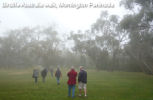
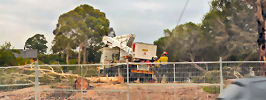 I found what struck me personally as egregious growthist propaganda dressed up as an academic research article on The Conversation, yesterday: "Blaming immigrants for unemployment, lower wages and high house prices is too simplistic." [February 23, 2018 11.26am AEDT]. The article was headed up by professor of economics, Robert Breunig from the Crawford School of Public Policy, Australian National University, and co-authored by Mark Fabian, Postgraduate student, Australian National University. Professor Breunig disclosed that he receives funding from the Productivity Commission, which I think is a leopard with continuously changing arrangement of spots according to whatever political background it needs to blend into for survival. Leith van Onselen's debate with Migration Council's CEO Carla Wilshire of the on the ABC’s National Wrapdocumented here, seems to illustrate this, but for all I know the professor and his student actually believe what they write.
I found what struck me personally as egregious growthist propaganda dressed up as an academic research article on The Conversation, yesterday: "Blaming immigrants for unemployment, lower wages and high house prices is too simplistic." [February 23, 2018 11.26am AEDT]. The article was headed up by professor of economics, Robert Breunig from the Crawford School of Public Policy, Australian National University, and co-authored by Mark Fabian, Postgraduate student, Australian National University. Professor Breunig disclosed that he receives funding from the Productivity Commission, which I think is a leopard with continuously changing arrangement of spots according to whatever political background it needs to blend into for survival. Leith van Onselen's debate with Migration Council's CEO Carla Wilshire of the on the ABC’s National Wrapdocumented here, seems to illustrate this, but for all I know the professor and his student actually believe what they write.
Criticising ex-PM Tony Abbott's extremely belated calls for reducing Australia's immigration-fed overpopulation problems, Breunig and Fabian write, “But migrants also bring capital, investing in houses, appliances, businesses, education and many other things. This increases economic activity and the number of jobs available.” It sounds like they are describing molecules in a heated gas.
Increasing economic activity increases impact on our environment and politically disempowers us. Massive population growth in this country is removing our choices of what we can buy with money, whilst inflating the cost of the reduced amenity and shelter that population growth is causing. That's impoverishing. Just on the business side, the cost of premises and paying wages so that employees can afford housing makes Australian businesses globally uncompetitive and provides an explanation for their mysteriously high rate of failure.
I am going to talk about how changes to laws and standards as to how our natural environment and urban spaces are treated and our rights within them are taking place without any meaningful public discussion or empowerment in order to allow growth to proceed.
Breunig and Fabian's article completely ignores the beautiful non-human environment we have in Australia, the green bits of which are being cut up into biogeographical islands, then paved over, subdivided and sold for ever higher monetary value. I suspect this failure to engage with nature is because its writers currently live in a bubble and simply don’t know or care about wildlife or green spaces or have compartmentalised this reality. So they are writing without my values or those of many other Australians or the values that attracted many immigrants.
Although there are laws for the protection of wildlife in this country, they are simply not applied. This is one reason that population growth can continue, for the recently beefed up Prevention of Cruelty Act 1986, the Fauna and Flora Guarantee Act 1988 and the Catchment and Land Protection Act 1994 would otherwise prevent the big business and government agenda for a big human population and infrastructure expansion.
I am, however, acutely aware, because I am involved personally, of how various authorities and contractors are expecting local wildlife carers and rescuers to clean up the huge callous mess and damage to flesh and blood that they are causing. Carers and rescuers are paying for artifical nests, feeding, nursing and medicating so many injured and displaced animals. Then those carers have to find some other place to release them, as habitat is destroyed all around them, whilst people like the authors of this article I am commenting on are claiming that the only problem about housing is failure to release land. We on this side of reality are fighting to stop the ‘release’ of land to bitumen and profit for a few in the growth lobby. (I am also qualified to talk about the growth lobby because I was the first person to write about it in Australia in a 2002 thesis - The Growth lobby in Australia and its Absence in France - which compared our system to the French one, which latter costs population growth as a cost to the public purse.)
Here are some examples of the callous vandalism that is taking place as we speak:
I live in Victoria and currently VicRoads and Melbourne Water are removing an extraordinary number of trees. For the expansion of the Melbourne metro rail project (which aims to cater for our artificially stimulated population growth) I have been informed that around 800 trees are being removed from urban Melbourne. Most of these are large mature trees, which have provided shade and enjoyment to people, and habitat for Australian wildlife, including birds and mammals. The public has not been consulted in any meaningful way about this. The St Kilda Road Avenue that leads to the war memorial and the botanic gardens, has been vandalised for this purpose. This avenue is a feature of Melbourne not unlike the Champs Elysees of Paris. To vandalise this is equivalent to a resounding slap across the face by Melbourne Planners of citizens who grew up here. Many find it shocking and distressing as a recent protest shows. /node/5413
But it is not just rail changes that are destroying wildlife habitat. Melbourne Roads have recently changed their policy on roadside and median strip vegetation, with absolutely devastating results for local climate, ammenity and habitat: /node/5304
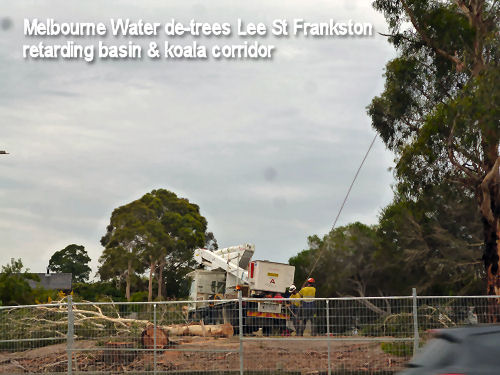
Then Melbourne water is now treating small local retardant basins as major dams, under the ANCOLD guidelines. Why are small retarding basins being treated as major dams? Because our 60% immigration fueled population growth has caused urban densification and the proliferation of hard surfaces. Although this was predicted by residents with foresight in many VCAT battles, these hard surfaces now carry the threat of major floods, so the small retarding basins that were adequate for many decades, now are deemed in need of reinforcement to bring them up to major dam status!
What has this got to do with trees and wildlife habitat and human amenity, you ask?
These new ANCOLD guidelines require the removal of all trees from ‘batters’ or dam banks. Since previous thinking caused the planting of trees because trees stabilise earth-forms, this ‘new’ thinking requires the removal of another huge quantity of mature trees, denuding much parkland throughout Victoria. Can you blame me if I suspect this is also to suit private developers and people who want land ‘released’ [from the commons and nature]?
The implications of these ANCOLD guidelines (which are now an Australian standard that is threatening green spaces all over the green bits surrounding this 70% hot desert and rangeland island) are staggering for the green wedges that follow Victoria’s rivers and creeks, their canopies cooling our environment through transpirational heat exchange, lowering water tables through the same transpiration, providing habitat for our wildlife and a green commons for our human spirits. Melbourne Water is in charge of more than 200 such basins. It pretends to follow guidelines to protect the displaced wildlife but in fact it does not have plans in place for their survival and reestablishment. It invites people to ‘revegetate’ what it has devastated, but our wildlife cannot wait for 25 yrs while trees grow to maturity, or 100 yrs plus until natural hollows occur. And the cheek of Melbourne Water to invite the people for whom its works have diminished their natural ammenity to replant such areas and not be paid! Insults added to injury. If you want to read more about this scandal, and its impact on wildlife, community and democracy, have a look at /node/5401 and https://awpc.org.au/awpc-to-melbourne-water-response-on-tree-removal-lee-st-retardant-basin/. Furthermore, there is a rumour that the Federal government is planning to make work like tree-planting mandatory for environmental organisations to qualify as tax-deductible. Slave labour for public works damage! And when every government leads with the plaintive cry of "Jobs!" This is where the labour is required.
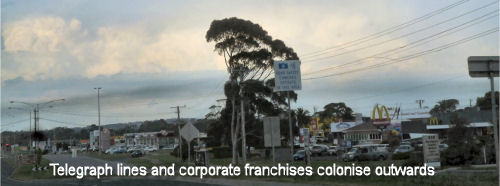
And it doesn’t stop there. Big money in densifying rural areas is impeding the passage of kangaroos to their feeding grounds, with the usual myth [See https://awpc.org.au/roo-scientists-admit-industry-stimulates-roo-population-growth-whilst-calling-roos-pests/ ] that there are ‘too many’ - a hollow farce familiar to the wildlife carers who must deal with the injuries that come from ‘gentlemen farmers’ taking potshots with permission from the ever generous and poorly overseen permissions to cull issued by DWELP: https://awpc.org.au/awpc-speak-out-against-the-culling-of-kangaroos-in-cape-schanck/.
And then there are there is the devastation caused by freeways and tollways created to ‘solve’ the congestion problems created by overpopulation. Money given to Parks Victoria by Peninsula Link for predator proof fences around scarce bandicoot habitat has been diverted to another program far from the original area, consolidating the damage that wildlife campaigners thought they might have mitigated in this place.
Of course the public think that Parks Victoria is looking after animals in the parks it manages for ‘healthy people’, but we cannot rely on Parks Victoria. See /node/2376 and /node/2377.
And the examples I give here are actually taking place at the mouth of the Mornington Peninsula Biosphere - scheduled for densification, of course. Shame!
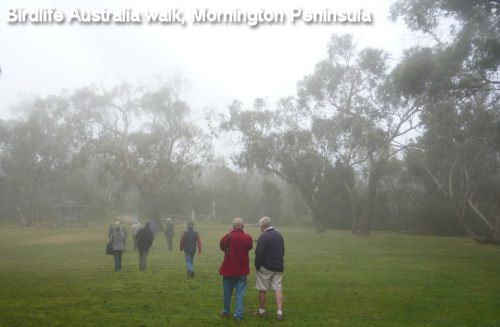
It is not the big-name conservation organisations but the hands on volunteers in organisations like AWPC (whose articles I have used as examples) that are doing the hard yards in this vicious losing battle against a delusional ideology fueled by speculative money that wants to increase human population despite our population being bigger by an order of magnitude than it has ever been for the bulk of its history. Does economics totally lack a sense of proportion or irony? The King Midas myth and the magic pudding pale against the science of modern economics which seems so similar to 17th century economics and official religion.
The notions put forward in the article I am commenting on simply stagger me in their unreal, coldly irrational model of the world we live in, biological human values, and what passes in The Conversation for research and analysis. Unfortunately these are the dominant models and values that are then acted on by governments and their contractors, in a great tragedy for this beautiful and fragile land that gives us all life.
![]() The Conversation claims "Academic rigour, journalistic flair," but is it just another agent of the Mainstream News affair complete with a mainstream news (MSN) editor, renowned by some for her incredibly boring political reporting which has put generations of Australians off politics in a great service to the elite? Unsurprisingly, the Conversation article, "White House under siege as scandal follows scandal – and it won’t end any time soon," by Kumuda Simpson, Lecturer in International Relations, La Trobe University repeats the scuttlebut that passes for political comment in the mainstream media, citing CNBC, the Washington Post and all the usual propaganda suspects. Far from encouraging the deep questioning and analysis one once expected of a university lecturer, Simpson is simply transmitting a flimsy political claim that President Trump should not carry on useful discussions with Russia about war and terrorism and Syria. Failing to present the other side, Simpson asserts that Russia cannot be trusted because it prefers to keep the Assad government (which he misnames a 'regime') in power, 'despite ongoing atrocities', which incredibly harmful allegation Simpson backs up by citing the latest egregious beat-up chorus against the Syrian Government as carried by the New York Times rag. ("Syrian Crematory Is Hiding Mass Killings of Prisoners, U.S. Says"). Candobetter.net Editor: UPDATE: Greg Wood's comments on the article discussed here were later all removed by the site editor. He is awaiting an explanation.
The Conversation claims "Academic rigour, journalistic flair," but is it just another agent of the Mainstream News affair complete with a mainstream news (MSN) editor, renowned by some for her incredibly boring political reporting which has put generations of Australians off politics in a great service to the elite? Unsurprisingly, the Conversation article, "White House under siege as scandal follows scandal – and it won’t end any time soon," by Kumuda Simpson, Lecturer in International Relations, La Trobe University repeats the scuttlebut that passes for political comment in the mainstream media, citing CNBC, the Washington Post and all the usual propaganda suspects. Far from encouraging the deep questioning and analysis one once expected of a university lecturer, Simpson is simply transmitting a flimsy political claim that President Trump should not carry on useful discussions with Russia about war and terrorism and Syria. Failing to present the other side, Simpson asserts that Russia cannot be trusted because it prefers to keep the Assad government (which he misnames a 'regime') in power, 'despite ongoing atrocities', which incredibly harmful allegation Simpson backs up by citing the latest egregious beat-up chorus against the Syrian Government as carried by the New York Times rag. ("Syrian Crematory Is Hiding Mass Killings of Prisoners, U.S. Says"). Candobetter.net Editor: UPDATE: Greg Wood's comments on the article discussed here were later all removed by the site editor. He is awaiting an explanation.
![]()
Comments under the article trended into a discussion about the validity of the MSN vs the 'alternative press', leading me to my analysis below. Phil Chamberlain's comment seemed typical of the fallacy that the official mainstream news is 'real news' because it uses 'real reporters' instead of opinion and that alternative news-sites are only opinions, which people use to confirm their own biases:
“The problem is that the so called MSM [Read proper journalism] will investigate facts and call to account”
This statement was written on The Conversation in rebuttal to another commenter who cited lack of faith in the mainstream media (MSM) and had the poor judgement to seek (as described by Mr Chamberlain) 'nutjob' info at 'dodgy' sites. Another commenter replied to this statement with some derision and pointing out that Murdoch and his media-magnate ilk exercise editorial control.
In fact the realm of journalistic control is huge and frighteningly pervasive.
When I read the statement that the MSM is 'proper journalism' and 'will investigate facts and call to account', I felt that oddly conflicted reaction that is all too frequent these days - laugh out loud nausea. It occurs when confronted with ridiculous notions that enable horrific contingencies to unfold.
It is not just Murdoch et al defining their journos’ agenda and editorial content. It has now compounded into self-censored homogeneity of editorial via a pervasive sense of ‘echo-chamber’ peer regulation. The journos are now so imbued with auto-recognition and compliance to their own ‘chook-house’ narratives that they’ve lost touch with real world facts and interpretative rigor.
The key elements sustaining the delusion seem to be a) the use of select facts at the persistent exclusion of others (disobedient facts) that are just as or even more critical to the matters at hand, and b) the interpretation of those select facts through a narrow premise base that remains unexamined for breadth or merit whilst being inculcated to the herd (of journos and thence the public) via its ceaseless implicit and explicit repetition.
Examples of assumption that are embedded and beyond examination include: “Russia is a global aggressor”; “Russia hacked the US election”; Mass, industrial scale migration and migration per se are the same thing; Far Right = opposition to (mass) immigration; that populism is bad, which by direct implication decrees that only the political/economic elite and their paid technocrats know what is good for us all. This utterly oversights the demonstrable premise that the elites have a globalised common interest that does not natively intersect with the ‘locals’ in any given area, thus the locals are ultimately dispensable in pursuit of the ‘common good’. (What a tortured concept that has become when measured at a national let alone global scale).
Examples of critical facts that are routinely ignored include: the benevolent outcome delivered in Crimea compared to the conflict in the Donbas; the fascist, CIA backed coup that gave Russian no choice but to act as it did; the fact that the Crimea is traditionally and until very recently was, Russian, and, in accord with this, Russia had international approval to station up to 20,000 military personnel in Crimea - accordingly it did not ‘invade’ Crimea; that Russia annexed Crimea when in fact the Crimeans voted overwhelmingly to become an autonomous republic within the Russian federation; the US and EU sanctions of Russia for this falsely alleged ‘annexing’ are illegal under WTO rules; that the US would go absolutely apeshit if Russia did in Cuba what NATO (the US) is doing in the territories bordering Russia; that cheerleading the downfall of Assad is exactly what has delivered Iraq and Libya into the toilet; that many of Marine Le Pen’s economic policies are in fact leftist - but she is ‘far right’ solely due to her rejection of the globalist agenda of open borders and mass migration. The latter is prime example of a macro(n) smear utilised to avoid merit-based debate on the highly vexed topic of mass migration as an economic tool to furnish elite advantage at the expense of local populations.
This linked video linked provides a concise and ultimately dangerous example of such wilful MSM delusion.
It presents Putin engaging a roundtable of western journos and directly challenging them to listen to him about the obvious but steadfastly ignored facts regarding who indeed is the geopolitical aggressor - Russia or the US? He clearly states that he does not expect them to report his factual position to their readers and he asks what will it take for them to listen - WW3?
The MSM deal with facts and investigation? What is the emoji for ‘rolling on the floor vomiting my guts up’?
 Mark Allen from Population Permaculture and Planning locks horns so to speak with West Australian Planning Professor, Professor Newman, over Melbourne's apartment proliferation, in discussion on the Conversation website relating traffic congestion to GDP rather than to population growth, and where the professor has suggested that increasing low cost, low quality, high density appartments would solve housing unaffordability. (If you wish to contribute on The Conversation site, please hit 'newest' on the 'Comments' section to read the latest dialogue at: https://theconversation.com/dont-panic-traffic-congestion-is-not-coming-for-our-cities-45154)
Mark Allen from Population Permaculture and Planning locks horns so to speak with West Australian Planning Professor, Professor Newman, over Melbourne's apartment proliferation, in discussion on the Conversation website relating traffic congestion to GDP rather than to population growth, and where the professor has suggested that increasing low cost, low quality, high density appartments would solve housing unaffordability. (If you wish to contribute on The Conversation site, please hit 'newest' on the 'Comments' section to read the latest dialogue at: https://theconversation.com/dont-panic-traffic-congestion-is-not-coming-for-our-cities-45154)
In a post in Mark Allen and Peter Newman's ongoing discussion Peter Newman has written that he believes that housing in-affordability created by urban consolidation can be solved "by building more high density housing at lower cost." He goes on to say that:
"Many people, perhaps you are one, prevent this as they only want to see high quality high density housing. They have been very successful at stopping high rise in Melbourne especially. This means the rich are moving in and the poor out."
So, does Professor Newman mean that if we build cheap low quality high-rise, we will solve all of our social inequity problems?
Mark Allen (Population, Permaculture and Planning) responded:
Very little of the massively overpriced high density in Melbourne is of high quality. Ironically the very few cases that I have seen of affordable housing have appeared at least, to be better quality, possibly because the architects had more to prove in terms of persuading planners and the community that affordable housing would not "detract" from the neighbourhood. If the standards of high density development in Melbourne were to be reduced any more, we would literally be building slums. Please do not assume that the high prices in Melbourne's apartment market translates into higher quality development. Property developers are using the urban consolidation mantra as an excuse to build high density, mainly for the overseas market and property investors. It is a build 'em quick, sell 'em high mentality. There is absolutely zero incentive for developers to market high density to people on lower incomes here in Melbourne and the investors that are being marketed to do not want prices to be brought down by cheaper units being built. Therefore I have learnt that urban consolidation can only work if a major component is, like you suggest, "social housing". I have also come to the conclusion that higher density development should not be constructed to such a scale that the character, heritage value and green spaces of our inner suburbs are adversely effected. I believe that greater emphasis should be placed on constructing European style medium-density town housing in the middle suburbs where many of the houses built in the 50's and 60's are coming to the end of their lives. There also needs to be a greater emphasis on increasing densities on the urban fringe by building TOD urban villages rather than low density suburbs (admittedly without the public transport but at least there would be an economic reason for it to come, even if it means waiting a few years). Finally we cannot ignore the issue of population growth. There needs to be an open and honest debate about how quickly our population should grow and whether slowing it would allow us time to plan more effectively as opposed to trying to keep up with accommodating ever increasing numbers. To promote urban consolidation as a magic bullet solution without looking at the wider context can therefore I believe, lead to really bad planning outcomes as is happening here in Melbourne.
Thank you for the article Peter. I am concerned however that Australian cities do face an increased congestion problem. Here in Melbourne the population is increasing by around 100,000 a year. In fact our infrastructure will need to be doubled in the next 30-40 years. The government's solution is to house this growth by means of urban consolidation, in this case large amounts of apartments close to railway lines. The idea is that people will use existing infrastructure; utilise the train or tram on their doorstep and car usage will be greatly reduced. The reality is sadly a bit more complex. Every new apartment is provided with a parking space for at least one car and many people utilise that space because while having a train on your doorstep is handy for some trips, it does not cover all of them by any means. So by building transport orientated development we are increasing car- usage in the inner suburbs and ironically as the focus is on creating origins rather than destinations along the public transport network, (i.e apartments rather than facilities and places of recreation etc) more and more car journeys are going to be needed as businesses and places of leisure are displaced by apartment building.
Peter Newman, Professor of Sustainability at Curtin University, in reply to
Its not what happens. If you build up densities around stations the main thing that happens is that people use local services much more as well as the transit system. The whole area becomes more walkable and less car dependent. Transit services go up and more local economic activity comes to the area. The cars are mostly left at home and eventually some households get rid of them altogether. It would be much better to have fewer parking spaces available from the start but that is often driven by fearful councillors not wanting people to park on the street.
Its 'not what happens' in theory but there is a growing body of research to show that this is what is happening here in Melbourne. The high price of real estate is such that many of the services currently available in transport nodes are being displaced by residential development to the extent that walkability is being lost. I agree that nevertheless people living in apartments in the inner suburbs will and are making far less journeys by car than those in the outer suburbs, but when you take into account the large numbers of people living in these transport orientated developments, you are looking at an overall increase in congestion by the sheer increase in the volume of people. This is despite the fact that per capita car-use is decreasing. I am not against urban consolidation as long as it is not dictated to, as it is at present, by the market. There has to be a component of affordable housing in the mix or else the construction of new apartments only goes to gentrify the areas in which they are constructed. This forces people on lower incomes to the urban fringes where car use is almost essential. Also, 95% of new apartments constructed in Melbourne are one bedroomed and therefore aimed at a narrow demographic which puts additional pressure on the urban fringe for those people who want to start families etc. Unfortunately I believe that the "increased densities around stations" mantra is being exploited by developers (etc) precisely because it is too simplistic and that it hasn't been subjected to enough scrutiny. I recommend that you strike up conversation with Professor Peter Buxton from RMIT in order to learn more about Melbourne's urban consolidation woes. Thank you for your insights.
Peter Newman, Professor of Sustainability at Curtin University
I am not talking theory I am telling you what we have measured happening. I am aware of the discussions in Melbourne and the fear of density being generated. I dont see anywhere that those fears have actually led to what you fear.
Mark Allen in reply to Peter Newman:
Professor Kevin O'Connor from Melbourne university recently made a damning assessment of the way urban consolidation is being carried out in Melbourne, citing the Docklands as a prime example. This follows in the footsteps of a similar assessment by Professor Peter Buxton. I am not talking about my fears here. I am basing my assessment on what academics in the field such as yourself, are saying. I understand that your claims are based upon measurements but the parameters are changing all of the time as the apartment boom continues to accelerate. Of course those parameters also vary massively from city to city.
By coincidence, this article was published on the Domain website today: Low-income renters are being forced to Melbourne's outskirts with areas that were once affordable now out of reach.
Low-income renters forced further to the outskirts of Melbourne
"The biggest drops in rental affordability over the past five years in Greater Melbourne were in the east and south-east; in the Mornington Peninsula, Frankston, Latrobe and the Yarra Ranges municipalities, according to the Department of Health and Human Services rental data.
Melton, Casey and Greater Dandenong – areas traditionally seen as some of Melbourne's most affordable – also recorded a significant decline compared to the rest of Melbourne.
The analysis echoes a similar finding in 2013, which showed Frankston, Greater Dandenong and Casey registered the greatest decline.
The data from the DHHS March Rental Report shows that the majority of Greater Melbourne's 32 municipalities had less than 60 affordable rentals".
Because the apartment boom in Melbourne is aimed at people in the higher income bracket without any thought for affordable housing, suburban sprawl is accelerating. It is a massive oversimplification to say that increasing densities in the inner suburbs stops suburban sprawl. If it is developer driven, it increases it.
Peter Newman in response to Mark Allen:
The issue of affordability in TODs or redevelopment in general is a universal one. You can address it by requiring a certain proportion of social housing or by building more high density housing at lower cost. Many people, perhaps you are one, prevent this as they only want to see high quality high density housing. They have been very successful at stopping high rise in Melbourne especially. This means the rich are moving in and the poor out. It does mean that the rich are driving less, and this is why we are seeing peak car, but our cities are becoming less equitable due to the anti-high rise movement.
>Mark Allen in reply to Peter Newman:
Very little of the massively overpriced high density in Melbourne is of high quality. Ironically the very few cases that I have seen of affordable housing have appeared at least, to be better quality, possibly because the architects had more to prove in terms of persuading planners and the community that affordable housing would not "detract" from the neighbourhood. If the standards of high density development in Melbourne were to be reduced any more, we would literally be building slums. Please do not assume that the high prices in Melbourne's apartment market translates into higher quality development. Property developers are using the urban consolidation mantra as an excuse to build high density, mainly for the overseas market and property investors. It is a build 'em quick, sell 'em high mentality. There is absolutely zero incentive for developers to market high density to people on lower incomes here in Melbourne and the investors that are being marketed to do not want prices to be brought down by cheaper units being built. Therefore I have learnt that urban consolidation can only work if a major component is, like you suggest, "social housing". I have also come to the conclusion that higher density development should not be constructed to such a scale that the character, heritage value and green spaces of our inner suburbs are adversely effected. I believe that greater emphasis should be placed on constructing European style medium-density town housing in the middle suburbs where many of the houses built in the 50's and 60's are coming to the end of their lives. There also needs to be a greater emphasis on increasing densities on the urban fringe by building TOD urban villages rather than low density suburbs (admittedly without the public transport but at least there would be an economic reason for it to come, even if it means waiting a few years). Finally we cannot ignore the issue of population growth. There needs to be an open and honest debate about how quickly our population should grow and whether slowing it would allow us time to plan more effectively as opposed to trying to keep up with accommodating ever increasing numbers. To promote urban consolidation as a magic bullet solution without looking at the wider context can therefore I believe, lead to really bad planning outcomes as is happening here in Melbourne.
Please hit 'newest' on the 'Comments' section to read the latest dialogue at: https://theconversation.com/dont-panic-traffic-congestion-is-not-coming-for-our-cities-45154
Recent comments